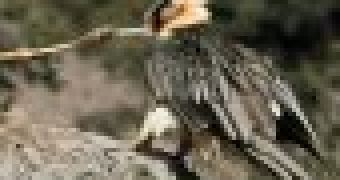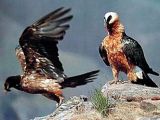You may believe that hyena with its formidable bone crushing jaws relies on bones for food. But hyenas are mainly meat eaters.
An animal especially evolved to feed on bones is not a mammal, but ... a bird! If vultures are known to strip the meat of the carcasses to the bones, this one will eat bones, too: the bearded vulture or lammergeier. A bearded vulture is impressive through its coloration and size: 3 m (10 ft) in wingspan and a weight of 5 to 7 kg (11 to 15 lbs)! As it eats more bones than flesh, its head is not bald like in the case of other vulture species.
This spectacular bird had to find something for replacing the bone crashing jaws: a special technique of its own. This bird carries up in the air, holding with its feet, big bones (this is the only vulture that can grab things!), that are eventually (when the bird has reached the right height and place) dropped. The bones fall on special rocks (called anvils and used for years and even generations) and an experienced individual will break apart the bone from the first trial.
The bird will eat not only the soft fatty marrow, but also the tough pieces of bone (rich in protein and minerals). Smaller bones are entirely ingested, without breaking them. The powerful gastric juices will dissolve them like the meat. This is the only species whose diet is based 90 % on bones and bone marrow, gaining the title of the planet's sole osteophage (whose diet is based on bones) species. Unlike other vultures, the bearded vulture will not touch rotten meat!
The same technique can be used for cracking turtles' shell; the bird will be able after that to feast on the reptile's meat.
The bearded vulture was once spread from the mountains of Europe to Himalaya and Tian-Shan (in western China) mountains in Asia and in all African mountains. In Europe they live at altitudes between 600 to 2.500 m (2,000-8,333 ft), but in Africa and Himalaya at heights of 4,000 m (13,333 ft).
In the last 200 years it has been encountered only in Europe just around Pyrenees (about 305 individuals, 85 % of the remaining European population), Corsica, Crete and northern Greece, while once it was found till the Alps (where a few individuals have been reintroduced in Austria coming from Spanish Pyrenees) and the Carpathians (where some peaks still bear its name). Only the Pyrenees population is expanding.
This species forms reproductive units made of 2-3 adults and nests on rocks between December and February. Even if there are two eggs, only one chick survives in nature and parents will take care of it for 4 months.
The main cause of their extinction in Europe was the poisoned corpses employed against predators, like wolves and bears. These birds were the first to reach a poisoned body, due to their sharp eyesight and the ability of flying. Poaching, too, has had its contribution to the decrease in number of bearded vultures.
The birds can also be annoyed at their breeding place by persistent human presence (farmers, shepherds, intense traffic, sky slopes).
One method employed by biologists to increase the number of bearded vultures is the assisted breeding. The eggs abandoned by parents in nature are incubated for 48-54 days, at constant temperature of 36.8o C and 37.5o C and 40-60 % humidity. At the hatching moment, the chick weighs 150 g (0.4 pounds). To avoid the creation of bonds between the chick and humans, it is fed through a puppet imitating the head of a bearded vulture. The problem with the chicks bred in captivity is that they have to learn the technique of breaking bones. If they manage this, they live up to 40 years.

 14 DAY TRIAL //
14 DAY TRIAL // 
